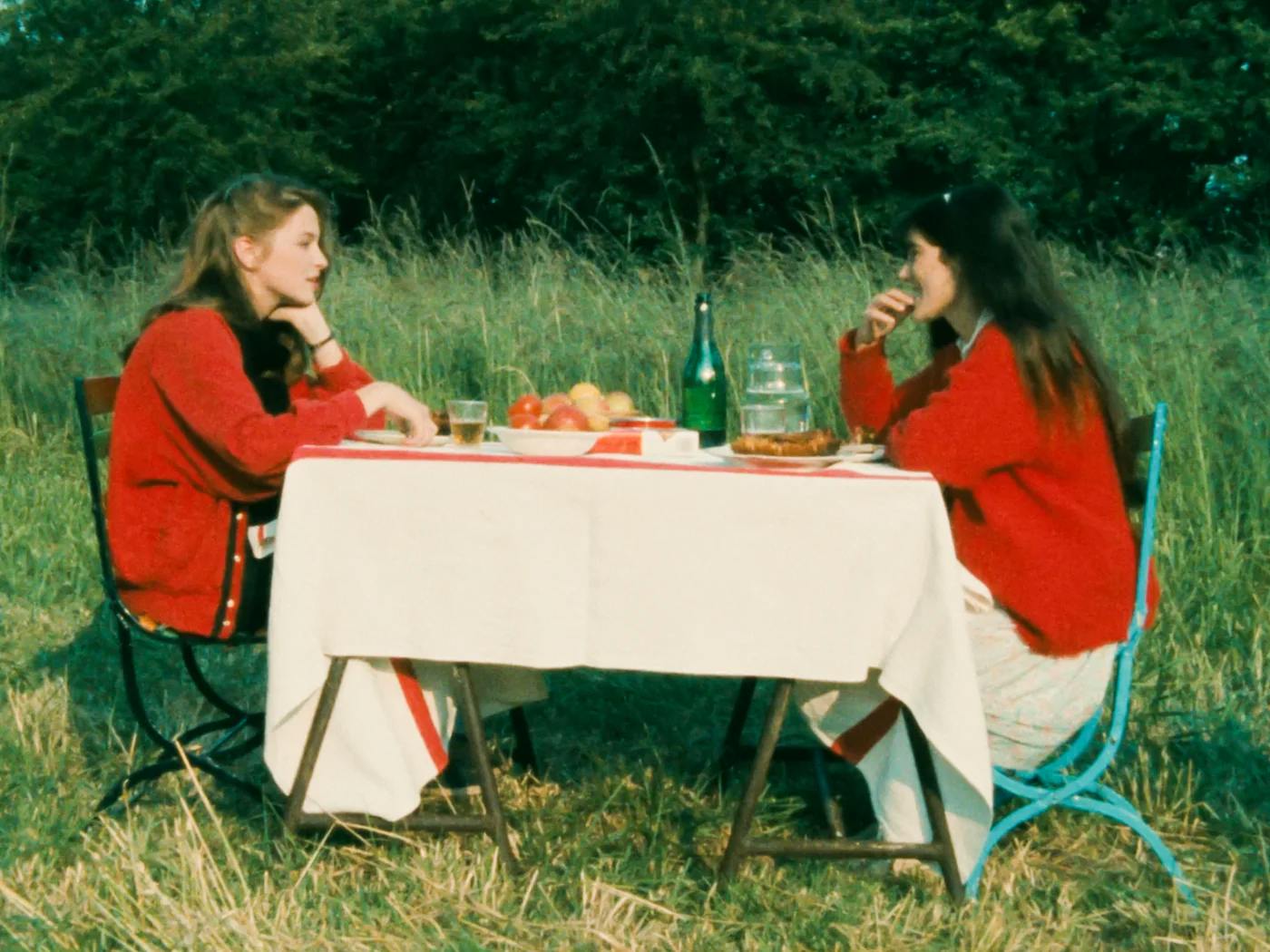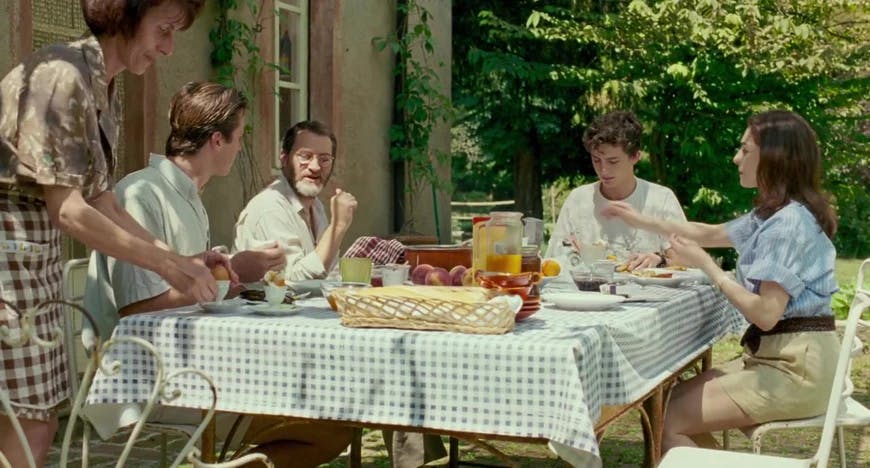
Food and Film: Recreating Cinema's Dining Table Magic
Evoking emotion, whether nostalgic or new, is something that connects both food and the world of film effortlessly. From romantic exchanges across a table set for two, to extravagant dinner parties that epitomise what it means to indulge every sense, cinema has forever captured the variety of experiences that come with dining and all that it represents.
Explore the beautiful ways food brings us together and get ready to relive (and recreate!) cinema’s most memorable table settings.
Four Adventures of Reinette and Mirabelle - 1987
A showcase of female friendship in its purest yet perhaps most confronting form, 1987’s Four Adventures of Reinette and Mirabelle follows the tale of two girls from opposing social backgrounds uniting in platonic love. Directed by Éric Rohmer, the film is split across four episodes and captures both the contrast and unity in values of friends from diverging worlds.
After Mirabelle's bicycle gets a flat tire near the converted barn where Reinette lives, the two cross paths for the first time before Mirabelle is persuaded to stay and observe the blue hour (the darker stages of morning and evening twilight, when the sun is furthest below the horizon) together. Over the days that the two continue to lean into their newfound friendship, one of the most charming cinematic moments of all unfolds, as the girls dine under a giant tree, drinking wine and eating dinner, they decide Reinette should move to Paris to study art and share Mirabelle's apartment. The scene is a defining one for both friends, learning to trust one another, allowing both of their experiences to shape their future and exposing the newfound safety they both feel in each other's presence. The seemingly smallest moments of decision can ultimately be the most life altering.
The table Reinette and Mirabelle share conjures up the joyous feeling that comes with alfresco dining, and the simple beauty of these moments amongst nature. Their table setting is similarly paired back, with a wicker fruit basket, glass water jug and simple crockery- the beauty of this setting is in the feeling that surrounds it.
RECREATE THE REINETTE & MIRABELLE TABLE
Ratatouille - 2007
The power of nostalgia and food is a recurring theme in Disney’s Ratatouille, however carries most poignance during the scene in which Remy cooks for renowned yet highly cynical food critic, Ego. With a sense of reluctance and natural disapproval, Ego raises a forkful of steaming vegetables to his mouth before his eyes widen and he is suddenly a boy of eight who has just grazed his knee riding his bike. The scene evokes warmth in every sense, as we see his mother comforts him before serving a steaming bowl of ratatouille, calming both his mind and body and relieving the big and small worries that occupy his childhood world. The scene perfectly captures what it means to revisit a memory through food, and perhaps more importantly, one that has long been buried or forgotten.
Ratatouille is a beautiful demonstration of the sensory power that food has over us, and as such one that should be cherished at all costs. Food can bring alive old versions of ourselves, and ignite states of being we may have feared lost.
Gusteau's restaurant is one that balances extravagance and charm, with its red carpets, draped velvet curtains and romantic chandeliers, it feels both lavish and welcoming all at once. A tablescape inspired by its best features celebrates bringing the most enticing parts of luxury dining into the comfort and warmth of your home and the memories that fill it.
RECREATE THE RATATOUILLE TABLE

Call Me By Your Name, 2017
From the peaches that have become synonymous with any mention of André Aciman’s 2007 book, to the beautiful outdoor settings Oliver, Elio and family share summer meals, Call Me By Your Name is a mesmerising display of food and pleasure. Whether it be picking fruit from the orchards of the Perlman’s estate, to communal, intimate conversations around the dinner table, the desire (and at times desperation) that comes with consumption is symbolic of both the joy that is derived from food during hot summer days, and that of Elio and Oliver’s growing attraction.
The outdoor table at which the family gathers each morning is one that celebrates the beauty of simplicity, sheltered partially by leaves dancing from surrounding trees, each scene at the table brings to life the familiar ease that comes with summer mornings before the summer sun becomes overwhelming.
Featuring a blue gingham tablecloth, terracotta cups and saucers and plain white egg cups, the table setting is one that likely feels reminiscent of fond, warm weather gatherings gone by.
RECREATE THE CALL ME BY YOUR NAME TABLE
Babette's feast - 1987
Set in the late 19th century, Babette's Feast follows two sisters of a strict religious community in a Danish village who take in Babette- a French refugee from the Franco-Prussian War- to work as their servant. In a surprise turn of events, Babette wins the lottery and to repay the sisters for their kindness, offers to cook a lavish French meal for the pair and their friends on what would have been their father’s 100th birthday.
A visual representation of food as a vehicle for love, Babette’s Feast is the sum of 14 years of gratitude, and in many ways dinner celebrates everything that cooking for others truly means. From the journey of purchasing and lovingly preparing her ingredients, Babette’s 7 course meal consisted of everything from Blinis Demidoff (buckwheat pancakes with caviar and sour cream) served with Veuve Cliquot Champagne to Savarin au Rhum avec des Figues et Fruit Glacée (rum sponge cake with figs and candied cherries). The feast is an outpouring of love in every sense, and a sensory experience that can be felt through the screen.
As magnificent as the dishes themselves, we turn to the table setting on which the feast is served. With glistening glassware, elegant chinaware, folded napkins and the glow of candles in abundance, the scene is a true picture of love and food uniting.
RECREATE THE BABETTE’S FEAST TABLE
